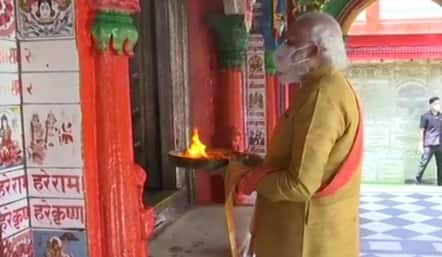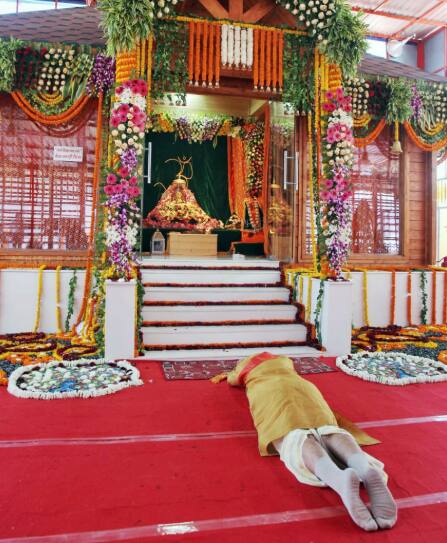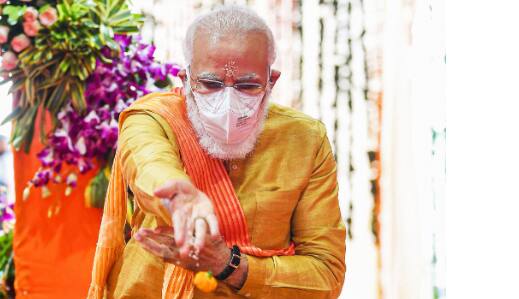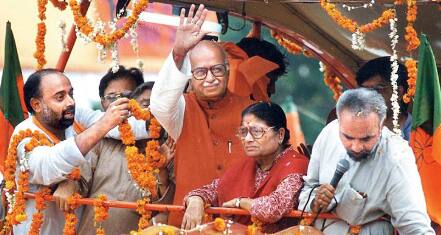New Delhi: Prime Minister Narendra Modi on Wednesday (August 5) reached Ayodhya after 29 years to lay the foundation of the Ram temple in Ayodhya. The last time, Modi visited the holy city when he was convenor of the Tiranga Yatra, a campaign led by Murli Manohar Joshi to scrap Article 370 that granted special status to Jammu and Kashmir.
According to the Uttar Pradesh government, PM Modi is the first Prime Minister to visit Ram Janmabhoomi, the birthplace of Lord Ram. He is also the first Prime Minister to visit Hanuman Garhi, the shrine to Hanuman. PM Modi today said that Lord Ram is a “symbol of good governance” and an “emblem of India’s unity in diversity.”
Earlier on Feb 5, 2020, the Prime Minister announced the setting up of Ram Temple trust in the Lok Sabha. “We have readied a scheme for the development of Ram Temple in Ayodhya,” he told the Lok Sabha, minutes after the Union Cabinet had cleared the move.
On November 9, 2019, the Supreme Court paved the way for the construction of a Ram Temple.
Sept 2019: Prime Minister Narendra Modi in a rally in Nashik had slammed the ‘loudmouths’ that were constantly talking about the Ram Mandir issue.
He said, “People have been given rubbish statements on the issue of Ram Temple. The entire country's people have faith in the country’s courts. It is important for the people to respect the Supreme Court. The SC is taking time out and giving a hearing to the case. I am surprised as to why some loud mouths are giving statements on the issue.”
Jan 2019: PM Modi told ANI that an ordinance to build a Ram Mandir would arise only after the Supreme Court, which is hearing the matter, delivers its verdict. He also blamed the Congress, especially those who have appeared as lawyers in the dispute, for delaying the judicial process in the Ram temple issue.
May 5, 2014: PM Modi invoked Lord Ram at Faizabad rally. With the portrait of Lord Ram providing the backdrop, he asked people "living" in the birthplace of the Hindu deity to teach Congress and those who support it a lesson for not fulfilling electoral promises.
"This is the land of Lord Ram where people believed in 'pran jaye par vachan na jaye' (one may lose life but cannot break promise). Can you pardon those who broke their promises?" he added.
1990: PM Modi was one of the organizers of a nationwide campaign to build a Ram temple to replace the 16th-century Babri mosque on the site. He never made a visit to the site and largely avoided mentioning the issue in his rallies.
Ram Temple movement: A timeline
1528: A mosque was built on the site by the then Mughal emperor Babur and hence, it is known as Babri Masjid.
1853: The first recorded incident of religious violence over the site took place.
1885: Mahant Raghubir Das files plea in Faizabad district court seeking permission to build a canopy outside the Babri Masjid structure. The court rejects the plea.
1934: A mob damaged parts of the disputed structure. Muslim prayers at the mosque and Hindu worship at Ram-Chabutra and Kaushalya Rasoi continue.
1949: Lord Ram's idols are allegedly placed inside the central dome. Both sides file court cases; the site is locked. The government declares the area as disputed and locks gates.
1950- Two suits filed in Faizabad civil court by the Hindu side in which it sought permission to worship the idols of Ram Lalla.
1959: The Nirmohi Akhara files a suit seeking possession of the site and claims to be the custodians of the disputed land.
1961: Mohammad Hashim filed a suit pleading for the restoration of the property to Muslims. The Sunni Central Wakf Board filed suit in Faizabad civil court declaring the Babri Mosque as the property of the board.
1984: Vishwa Hindu Parishad (VHP) launches a campaign for the construction of the Ram temple at the Janmabhoomi site.
1986: Ayodhya district judge ordered that the gates of the disputed mosque to be opened to allow Hindus to worship there, on a plea by Hari Shankar Dubey. Muslims set up the Babri Mosque Action Committee in protest.’
1989: VHP lays the foundation of a Ram temple on land next to the Babri Masjid following permission from the then Rajiv Gandhi government
September 25, 1990: Then BJP President L K Advani launches his Rath Yatra from Somnath to Ayodhya. He is arrested in Bihar’s Samastipur in November
December 6, 1992: The disputed Babri Mosque is razed to the ground by Karsevaks.
April 3, 1993: The Central government had passed ‘Acquisition of Certain Area at Ayodhya Act’ for the acquisition of land in the disputed site.
April 2002: Three-judge Bench of high court begins hearing to determine the ownership of land. The HC orders the Archaeological Survey of India (ASI) to excavate the site to determine if it was a temple earlier.
2003: ASI finds evidence of the presence of a temple under the mosque. Muslim organisations dispute the findings.
September 30, 2010: The Allahabad High Court ruled the disputed land be divided into three parts — one-third to Ram Lalla Virajman, represented by the Akhil Bharatiya Hindu Mahasabha; one-third to the Sunni Waqf Board; and the remaining to the Nirmohi Akhara. In December, the parties move the Supreme Court.
May 2011: The Supreme Court stayed the Allahabad High Court order.
March 21, 2017: The SC said that the matter is sensitive and suggests it be settled out of court. It asks stakeholders to hold talks and find an amicable solution.
September 2018: The Supreme Court rejects the plea for a review of the 1994 Farooqui judgment but then clarifies that it would have no bearing on pending title suits.
October 2018: The Supreme Court decides that the land dispute case will only be listed before an “appropriate Bench” in January 2019.
January 8, 2019: The Supreme Court sets up a five-judge Constitution Bench to hear the land dispute case.
January 29, 2019: The Supreme Court puts out a notice that the Constitution Bench hearing the Ayodhya title suit appeals will not be sitting on January 29 as one of the judges, Justice SA Bobde, is not available on the day.
March 8, 2019: Supreme Court orders mediation for the ‘permanent solution’ of the politically sensitive Ram Janmabhoomi-Babri Masjid land dispute case. A bench headed by Chief Justice Ranjan Gogoi said that the mediation process will be held in Faizabad on-camera but barred media from reporting the proceedings.
May 10, 2019: Supreme court granted a mediation panel headed by a former judge, Justice F M I Kalifullah, further time till August 15 to find an amicable solution of the dispute. However, the panel failed to come to any conclusion.
August 6, 2019: The top court begins marathon hearing on a day-to-day basis.
October 16, 2019: The Supreme Court reserved its judgment in the case.
November 9, 2019: The Supreme Court delivers its verdict. The SC ruled that the land belongs to Ram Lalla and ordered the government to provide an alternative five-acre land to the Sunni Waqf Board.
December 12, 2019: The Supreme Court rejected multiple pleas for a review of its November 9 ruling handing over the land in Ayodhya to Ram Lalla.
February 5, 2020: Prime Minister Narendra Modi announces the formation of a 15-member Shri Ram Janmabhoomi Teerth Kshetra to oversee the construction of a Ram Mandir at the erstwhile disputed site in Ayodhya.
February 19, 2020: Shri Ram Janmabhoomi Teerth Kshetra Trust appoints office-bearers.
August 5, 2020: PM Modi conducts Bhoomi Pujan of Ram Temple construction in Ayodhya, laying the foundation stone.





















